Spring Pearl Couscous Salad with Asparagus and Dill
The perfect recipe for asparagus season, this spring pearl couscous salad is a great way to utilize seasonal vegetables! Paired with a bright lemon dressing, this salad is out of this world.
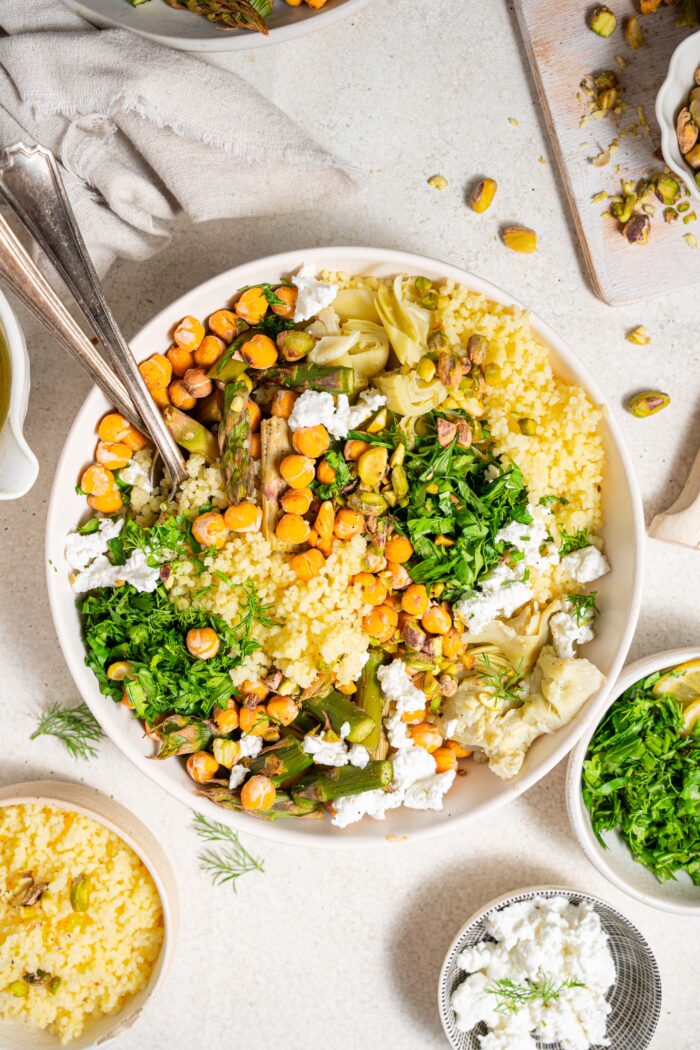
Using local seasonal produce is a great way to reduce your carbon footprint. If you’re a fan of environmentally friendly recipes, you will LOVE my second cookbook, PlantYou Scrappy Cooking. It’s all about making the most of your ingredients and getting creative in the kitchen!
Just like my first cookbook, the Scrappy edition includes simple, beginner-friendly recipes and visual ingredients index for every single meal. Plant-based cooking has never been easier!
This spring pearl couscous salad recipe follows the same principles. It makes use of asparagus, which is in season between April and June in the Northern hemisphere.
This recipe is also designed in a way that meets the nutrition criteria, including protein, cabohydrates, fats and dietary fiber.
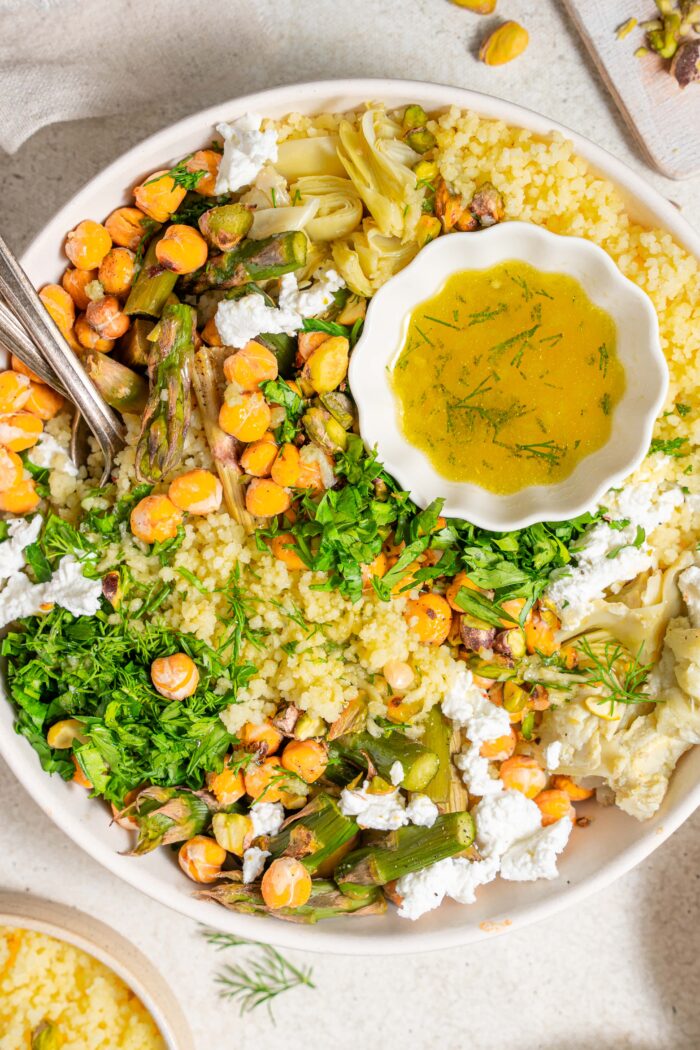
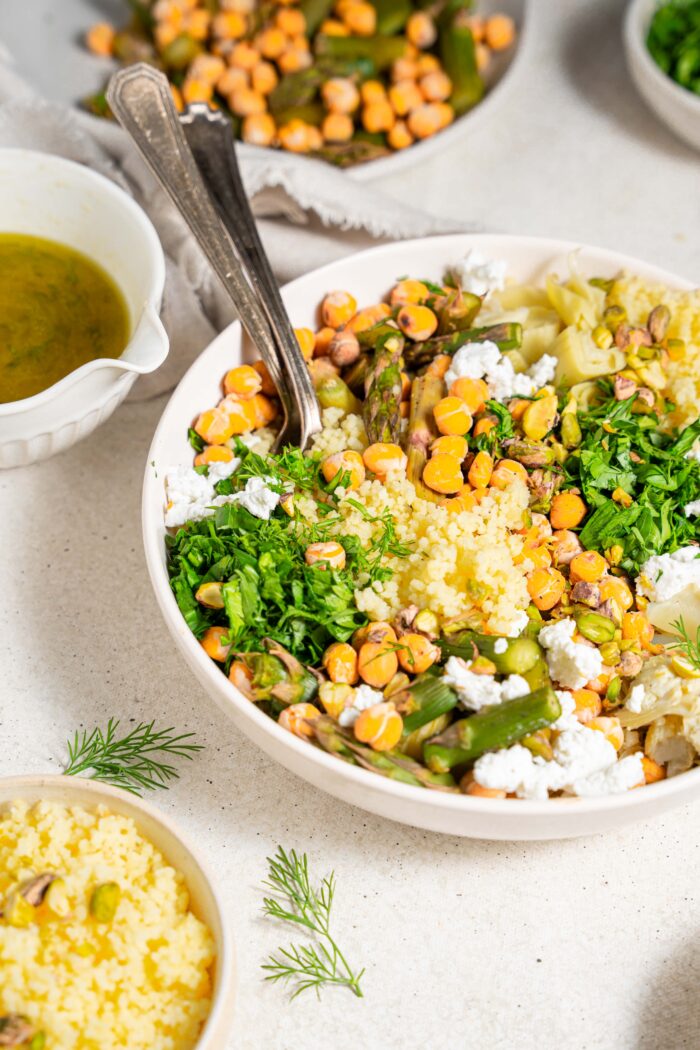
Why You’ll Love This Recipe
- If you love asparagus as much as I do, this spring pearl couscous salad is an easy and convenient way to utilize this vegetable.
- Similarly, couscous is an underrated salad base. It works so well with almost any ingredient, and helps to bolster the salad, too.
- We all know that dressing can make or break a salad. This spring pearl couscous salad comes with a refreshing, tangy lemon dressing. It helps to elevate all the other ingredients and bring everything together.
- This recipe really shows that salads don’t have to be boring or bland! Instead, this spring pearl couscous salad is filling and flavorful.
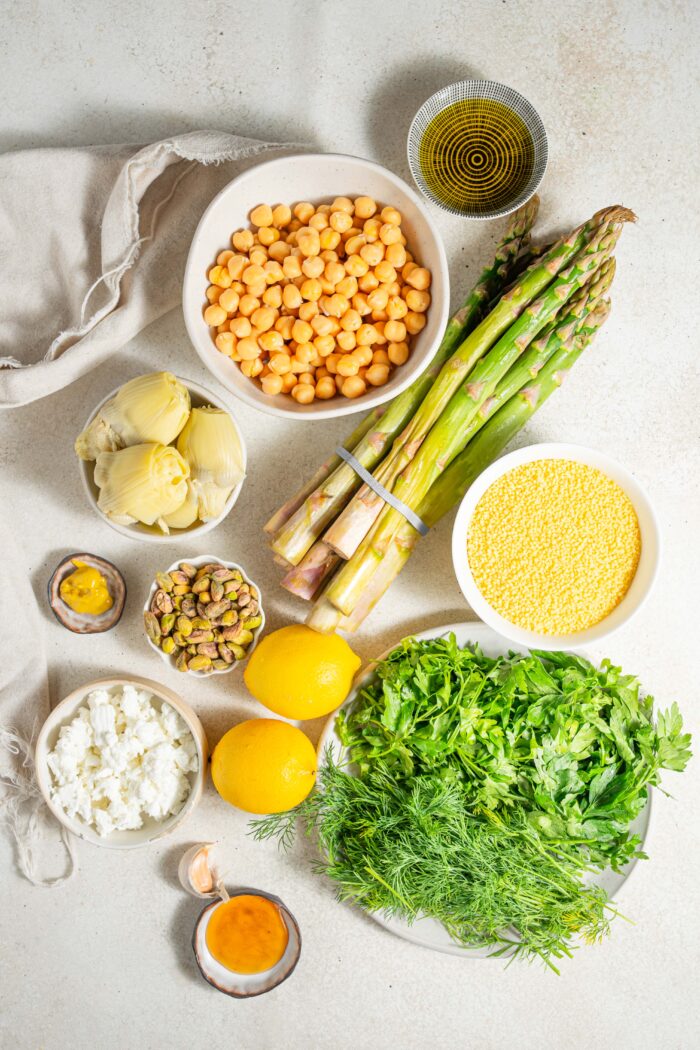
Benefits of Asparagus
Asparagus is best enjoyed during its peak season, which typically runs from late March to early June in the Northern Hemisphere. During this time, asparagus is at its freshest and most flavorful.
- Nutrient-Rich. Asparagus is low in calories but full of with essential nutrients such as vitamins A, C, E, and K, folate, potassium, and fiber.
- Antioxidant Properties. Asparagus contains antioxidants like vitamins A, C, and E, as well as flavonoids and polyphenols, which help neutralize harmful free radicals in the body and reduce inflammation.
- Digestive Health. The fiber content in asparagus supports digestive health by promoting regular bowel movements and preventing constipation.
- Heart Health. Asparagus is rich in potassium, which helps regulate blood pressure and reduce the risk of cardiovascular diseases. It also contains folate, which is essential for heart health and helps lower levels of homocysteine, an amino acid linked to heart disease.
- Diuretic Properties. Asparagus contains natural compounds that act as diuretics, promoting the production of urine and aiding in the elimination of excess salt and fluid from the body. This can help reduce bloating and support kidney health.
- Blood Sugar Regulation. The fiber and antioxidants in asparagus may help stabilize blood sugar levels and improve insulin sensitivity, making it a beneficial food for individuals with diabetes or those at risk of developing diabetes.
Overall, asparagus is a delicious and nutritious vegetable that can be a great addition to salads, stir-fries, soups, and side dishes.
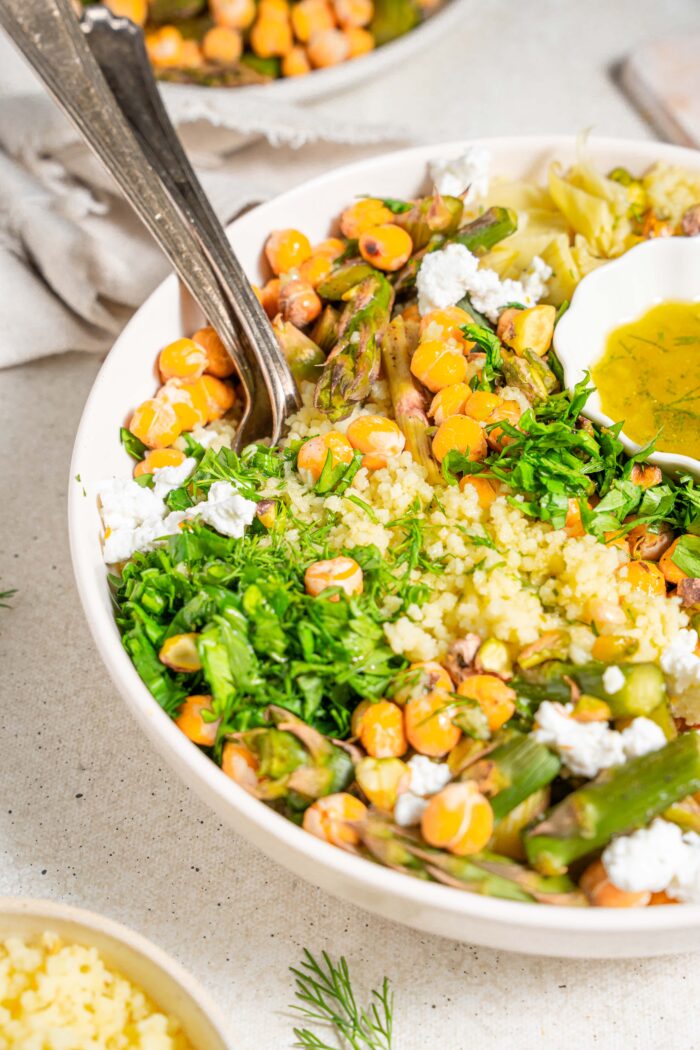
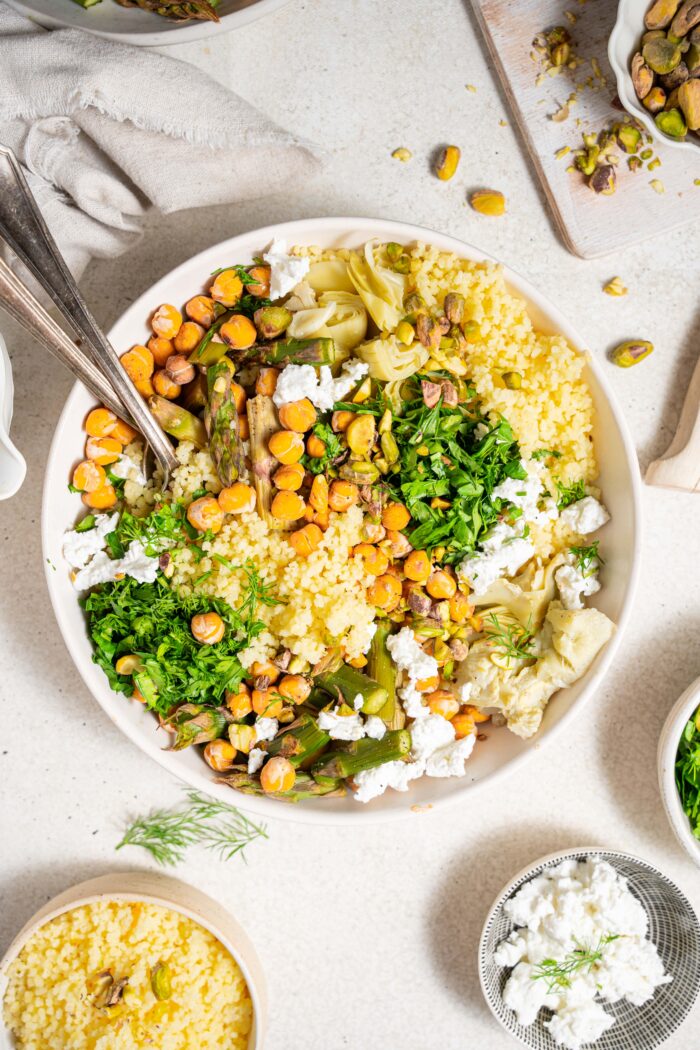
What is Couscous?
Couscous is a staple food in North African cuisine, made from tiny granules of durum wheat or semolina flour. In recent years, couscous has gained popularity worldwide due to its quick cooking time and ability to absorb flavors from other ingredients.
Couscous is often mistaken for a grain, but it is actually closer to pasta. Traditional couscous is made from semolina flour, which is a coarse flour made from durum wheat. The process of making couscous involves rolling and shaping moistened semolina wheat into small granules, which are then dried.
Pearl couscous, also known as giant couscous, is larger in size compared to traditional couscous. It has a round shape and a chewy texture, similar to small pasta pearls. Because of its size, giant couscous typically requires longer cooking times.
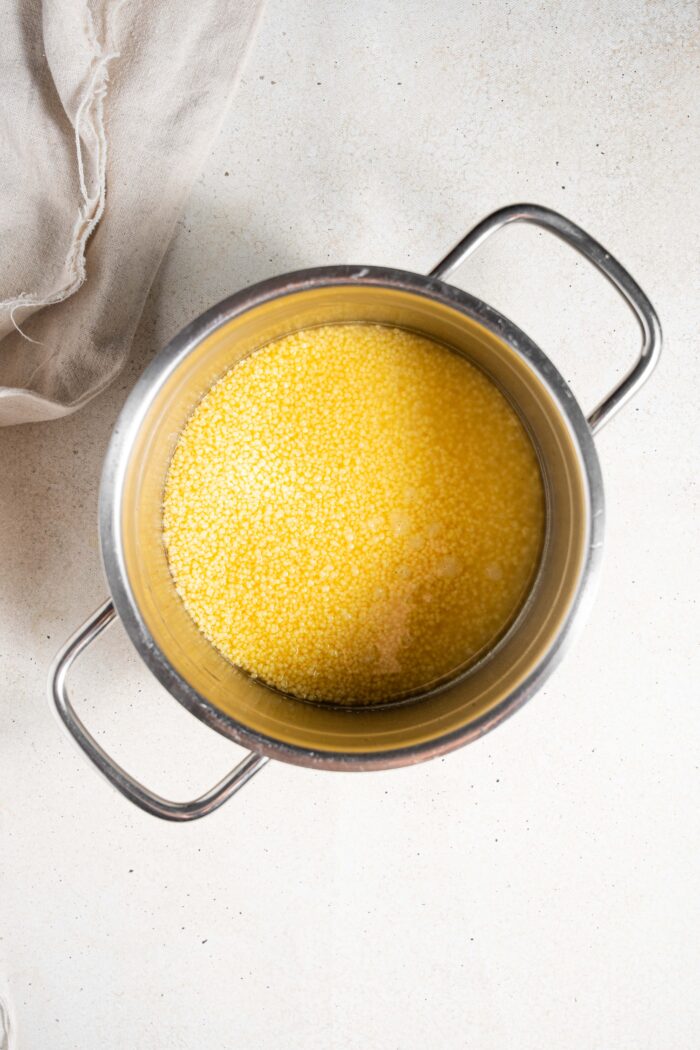
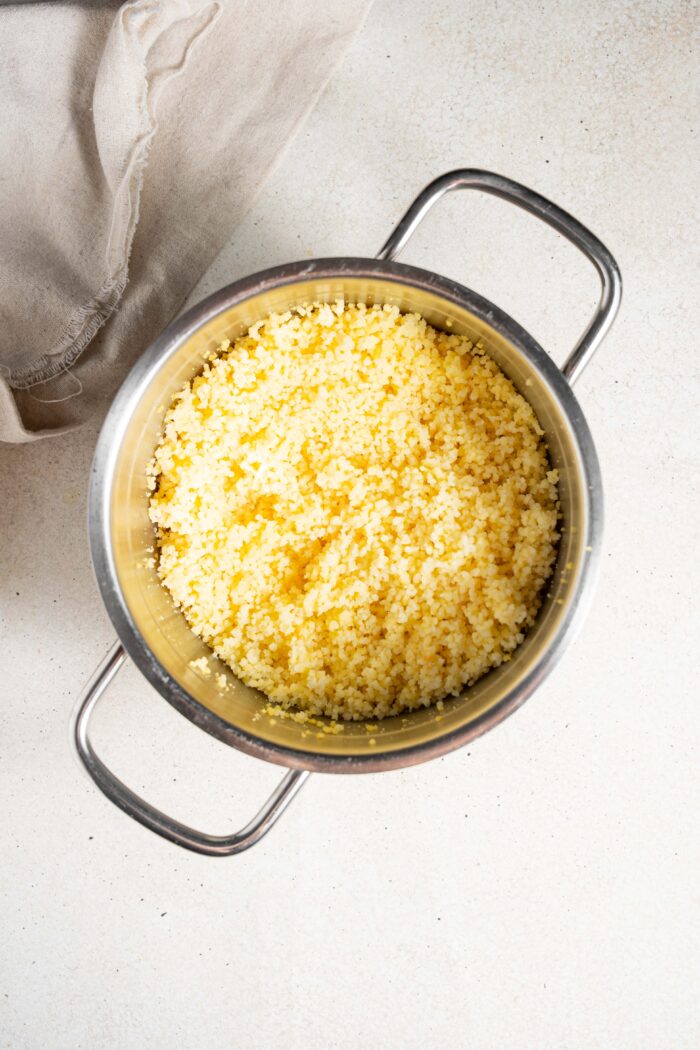
How to Make This Recipe
First, we need to cook the couscous. Check the package instructions for cooking time, and cook the couscous in vegetable broth instead of water. This will make the pearls absorb flavors of the broth.
There shouldn’t be any liquid left when the couscous is ready. Turn off the heat and allow it to cool before making the salad.
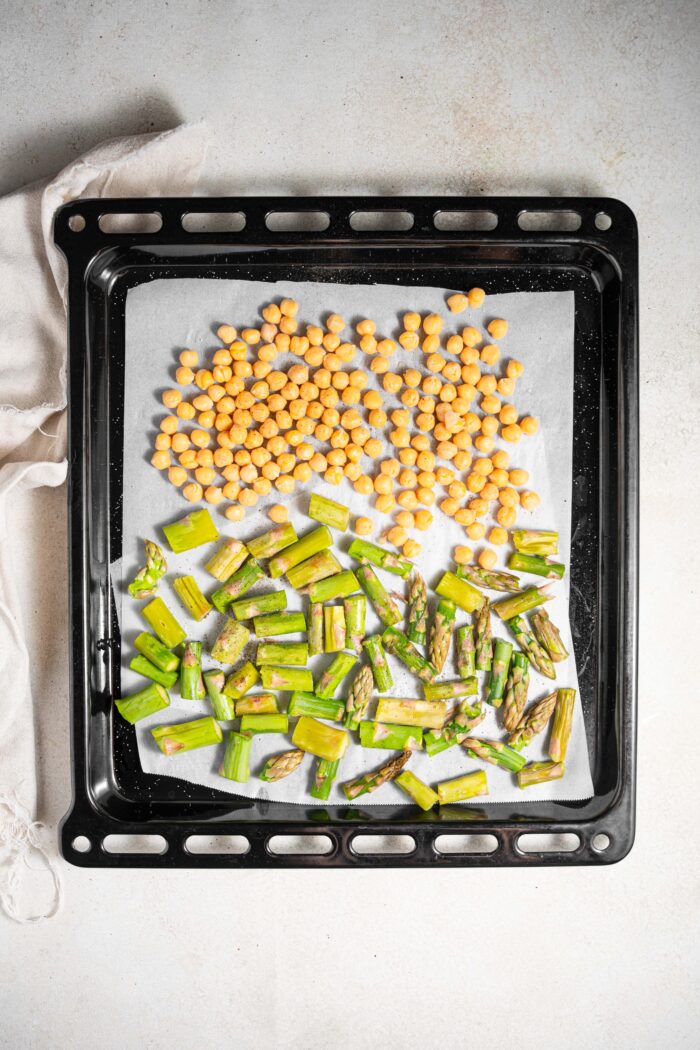
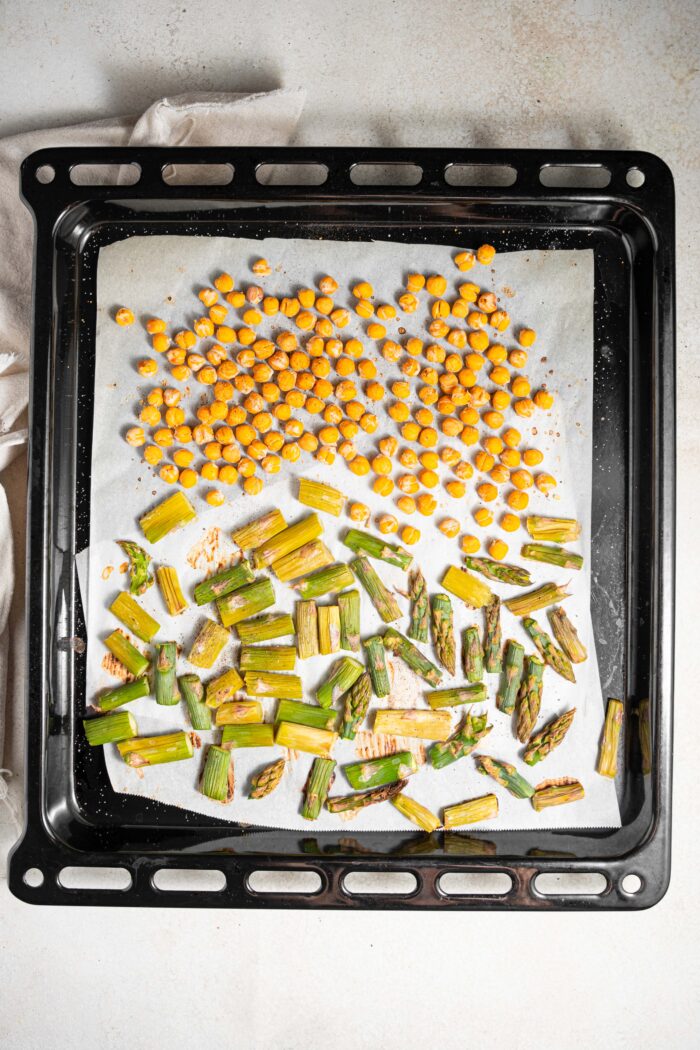
Meanwhile, we will roast asparagus and chickpeas. Preheat the oven to 400F and line a baking sheet.
Add the asparagus and chickpeas to the sheet pan, and drizzle some olive oil on top (optional). Sprinkle with salt and pepper and bake for 15-20 minutes. You’ll know the asparagus is ready when it’s tender.
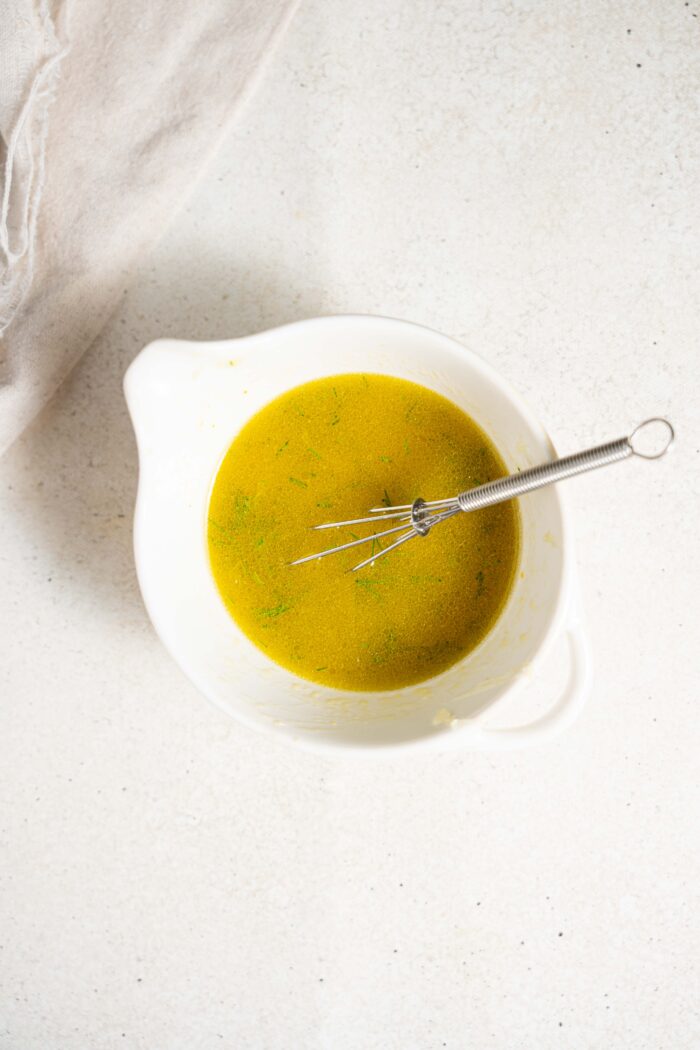
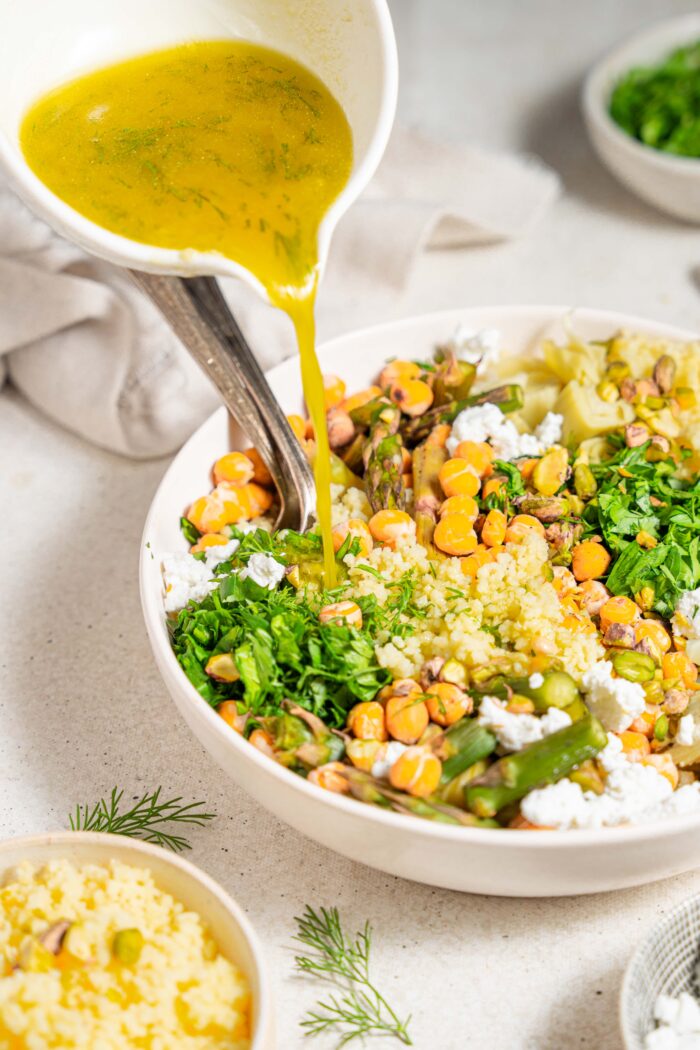
Next, make your dressing. Whisk together lemon juice, olive oil, minced garlic, dijon mustard, dill, maple syrup, salt, and pepper.
Once all the individual components are good to go, add the couscous, asparagus, chickpeas, herbs, vegan feta (if using), and pistachios to a bowl. You can pour the lemon dressing over the top or serve it on the side.
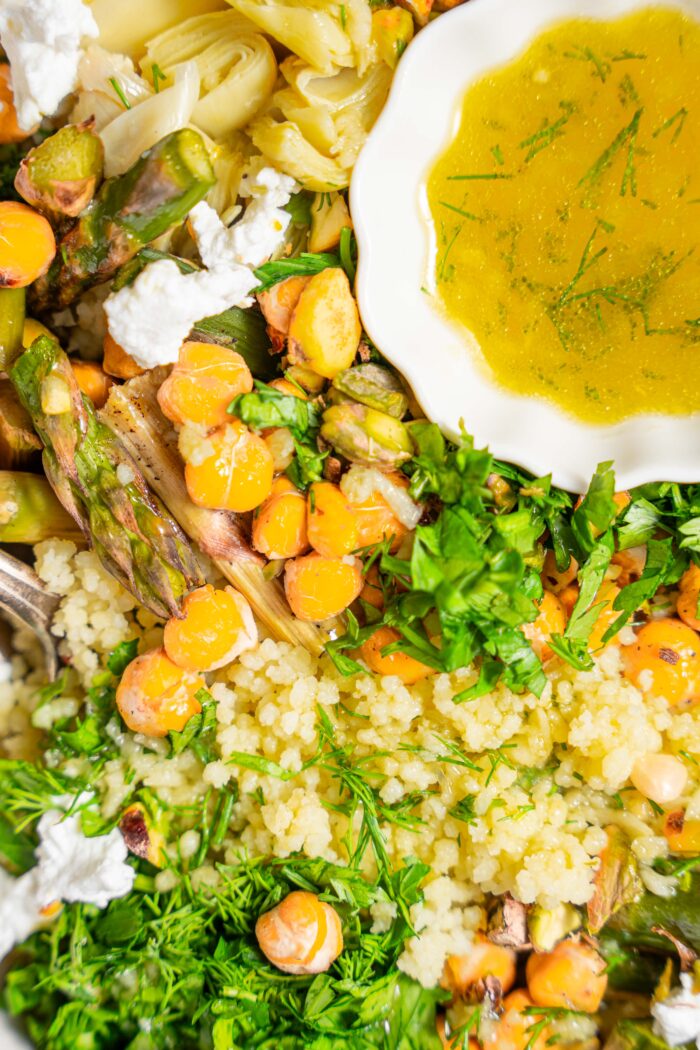
Hack It!
- The beauty of this lemon dressing is that it works with other cirtus fruit, too! Try it with lime, orange, grapefruit, or a combination of fruit.
- If you’re allergic to nuts, substitute pistachios for toasted seeds, such as sunflower, pumpkin, or sesame.
- While vegan feta is optional, I highly recommend adding it to your spring pearl couscous salad. And if your local stores don’t carry it, there is a handy recipe in the Scrappy Cookbook!
- This recipe yields 4 and can be stored in the fridge for up to three days. If you live in a small household, this is a perfect meal prep recipe!
- Since couscous contains gluten, you can swap it for gluten-free version, quinoa or rice.
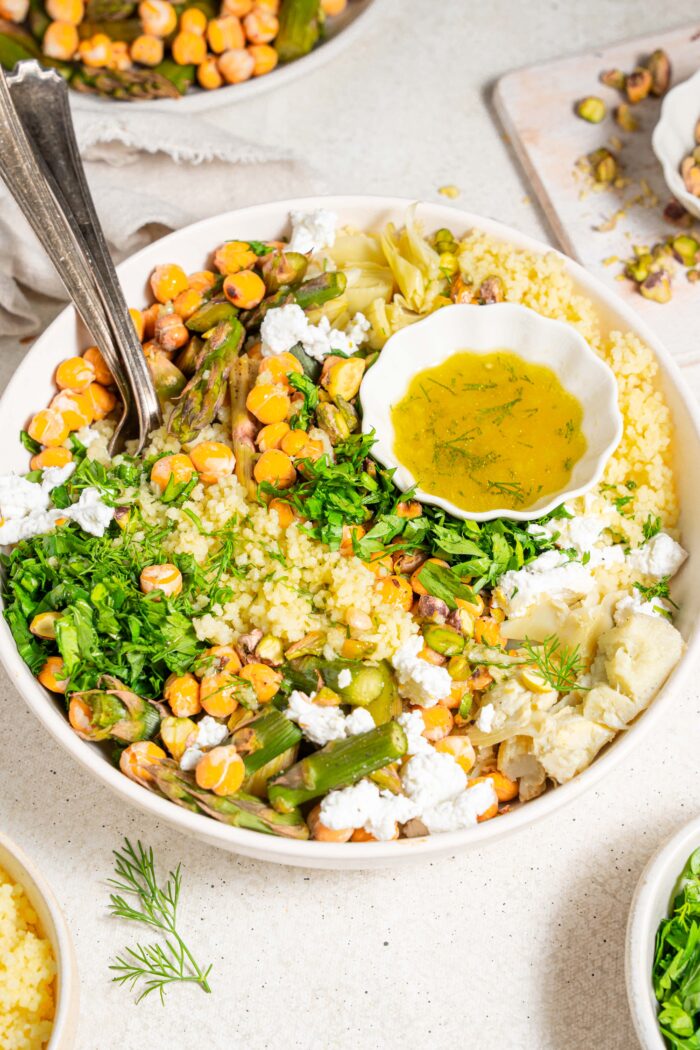
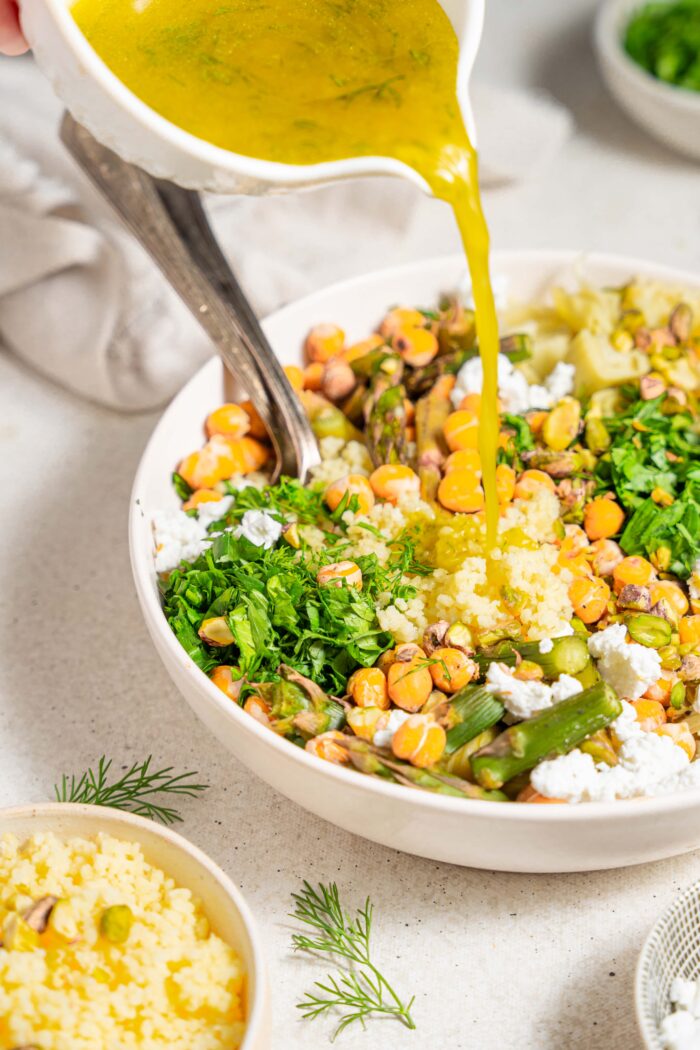
Other Recipes You’ll Love
- Warm Broccoli Couscous Salad
- Lentil Quinoa Salad
- Street Corn Pasta Salad
- Easy Vegan Greek Bowl
- Plant-Based Caesar Salad
If you loved this couscous salad, let me introduce you to the PlantYou Planner! It’s like your personalized meal planning assistant, offering up 600+ easy vegan recipes.
The best part? You try out the free version with 25 awesome plant-based recipes and our top-notch beginner vegan meal plan.
Oh, and the icing on the vegan cake is that I’ve teamed up with an incredible women-led business to create Complement x PlantYou Essential. It’s a powerhouse multinutrient supplement specially crafted for all you plant-based champs out there. This is a game-changer that makes thriving on a vegan diet an absolute breeze.
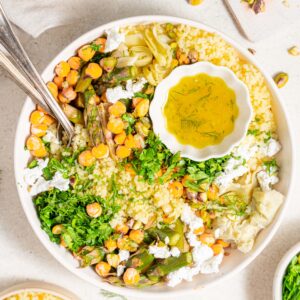
The Recipe: Spring Pearl Couscous Salad with Asparagus and Dill
Ingredients
- 1 bunch asparagus, chopped
- 18 oz canned chickpeas, drained and rinsed
- 6 artichoke hearts, marinated, chopped
- 1 cup fresh dill, chopped
- 1 cup fresh parsley, chopped
- ¼ cup pistachios, or nut of choice, chopped
- ¼ cup vegan feta, optional
For the couscous
- 1 cup pearl couscous
- 1¼ cup vegetable broth, or more as needed
Lemon dressing
- 2 lemons, juiced
- ¼ cup extra virgin olive oil
- 1 clove garlic, minced
- 1 tbsp dijon mustard
- 1 tsp fresh dill, chopped
- 1 tsp maple syrup
- salt and pepper, to taste
Equipment
- large pot for couscous
- Parchment
- Jar for the dressing
Instructions
- Cook the couscous according to package directions, in vegetable broth instead of water, if desired. Allow to cool slightly before serving.
- Preheat the oven to 400F and get out a baking sheet. Add the asparagus and chickpeas to either half of the sheet pan, and toss in olive oil if desired. Sprinkle with salt and pepper. Bake for 15 to 20 minutes, until the chickpeas are slightly crispy and the asparagus is tender.
- While the asparagus and chickpeas cook, make your dressing. Combine all listed dressing ingredients in a measuring cup until a smooth dressing is formed.
- To a bowl, add the cooked couscous, asparagus, chickpeas, dill, parsley, vegan feta and pistachios. Drizzle on the lemon dressing and toss. Enjoy immediately, or store in the fridge for up to 3 days.

